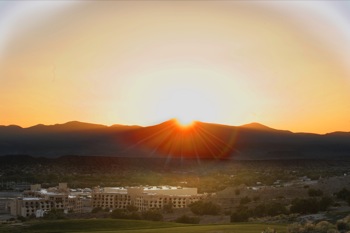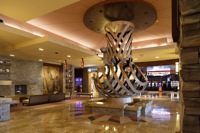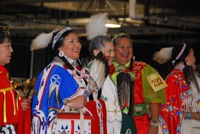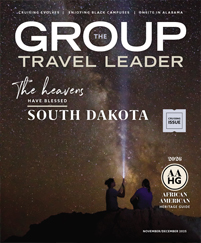 Photo courtesy Thunder Resort and Casino
Photo courtesy Thunder Resort and Casino
Take a break from your slot machine, roulette wheel or poker table, and look up — that imaginative, artistic figure hanging on the wall or ceiling in front of you may mean more than you think.
The advent of gaming facilities on reservations and tribal lands has helped to remake the fortunes of many Native American groups in the United States. In many places, Indian casinos rank among the top tourist attractions at a destination.
But these places aren’t just prefabricated Las Vegas exports — many Native American casinos and resorts across the country go to great lengths to educate visitors about the culture and history of the tribes that own them.
At some properties, ancient symbols and handmade native arts decorate gaming areas and guest rooms, giving subtle indicators of the local tribe’s roots. Other properties have more involved cultural elements, such as museums, exhibits and special events that reflect their Native American heritage.
Mohegan Sun
Uncasville, Conn.
When the Mohegan tribe of Connecticut set out to construct its casino, leaders enlisted the help of Melissa Tantaquidgeon Zobel, a tribal historian and medicine woman, to incorporate their traditions into the design.
 |
| Courtesy Mohegan Sun |
“I worked on all phases of the design before there was even a casino,” she said. “We had this wonderful opportunity to use every square inch of what we had to really shout about our tradition. We wanted you to feel what it meant to be Mohegan when you walked inside. We wanted you to experience that in our design and colors.”
The effort led to a thorough integration of Mohegan customs and tradition into nearly every aspect of the casino. Even the Mohegan Sun logo, with brightly colored icons pointing in the four cardinal directions, reflects ancient symbols of the Mohegan people.
The resort’s gaming space is broken up into three areas — Casino of the Earth, Casino of the Sky and Casino of the Wind — that have been designed to highlight the importance of these natural elements to the tribe.
“The Casino of the Earth is shaped in a circle, and it’s also divided into four directions and our four symbols,” Tantaquidgeon Zobel said. “It’s focused on our ancient past. The Casino of the Sky is more focused on the transition into the future and contact with the Europeans. The most recent casino, the Casino of the Wind, has very specific symbols associated with the wind.”
Throughout each section, custom artwork handmade by tribal members helps to underscore the different themes. Even the building materials reflect the natural resources that were historically used by the Mohegan tribe.
“We talked a lot about things like metal,” Tantaquidgeon Zobel said. “We don’t have silver and gold, but traditionally, we have copper. So you’ll see tremendous amounts of copper around the casino.”
Visitors who are especially interested in cultural heritage at Mohegan Sun can pick up the Secret Guide, a booklet that details paintings, mosaics, architecture and other significant Mohegan elements throughout the property.
Downstream Resort Casino
Quapaw, Okla.
Opened in phases during 2008 and 2009, Downstream Resort Casino features a gaming floor with 2,000 slot machines, as well as a resort-style hotel and a number of restaurants and bars. The Quapaw tribe of Oklahoma and Arkansas owns the casino and has integrated some of its special symbols and artwork into the property’s decor.
 |
| Courtesy Downstream Resort Casino |
“The development authority was heavily involved to make sure we were using some of the heritage that had been involved with the tribe for hundreds of years,” said public relations manager Sean Harrison. “They’ve got a lot of Native American art that they utilize throughout the food and beverage outlets. And there are different artifacts displayed in those areas and a lot of pictures going back to the tribal history.”
One common design element found throughout the casino and hotel is a swirl pattern, which comes from centuries-old tribal artwork.
“The swirl pattern is something that the tribe incorporated in their pottery years ago, when they were in the Arkansas territory,” Harrison said. “There’s a swirl design that they have embedded in their artwork that shows some of the different spokes of their tribe. It has specific meanings, and the tribal members can pick them out fairly easily.
“You’ll see the swirl pattern throughout the architectural design,” he continued. “The swirl patterns throughout the facility really tie back to the initial culture and pottery designs.”
Visitors will also see the pattern in pottery displayed in the hotel lobby. Other historic artifacts are on display there, too, including moccasins and traditional blankets.
The casino and hotel managers are in the process of printing a brochure to give guests a brief history of the casino and the Quapaw tribe, who call themselves the Downstream People.
Buffalo Thunder
Resort and Casino
Santa Fe, N.M.
As you approach Buffalo Thunder Resort, your first clue to its heritage is the striking adobe architecture, which seems to rise naturally out of the landscape surrounding Santa Fe. Once you’re inside, you’ll see the traditions of the Pojoaque Pueblo reflected all around you.
“One of the things that’s so interesting about this property is that George Rivera, the governor of this pueblo, is also an amazing artist,” said public relations representative Jennifer Marshall. “He was instrumental in all aspects of the architecture, and all of the furnishings reflect Pueblo designs.
“All throughout the property is different art — more than 200 pieces of Native American art. We’re talking big-deal names, as well as the governor himself. He’s proud of his work, but he’s also a major collector and promoter of other artists in the area.”
The first major piece of artwork that guests notice upon entering the property is Buffalo Dancer, a 12-foot-high stone sculpture that depicts Pueblo people performing a ceremonial dance that celebrates the buffalo. The sculpture was done by Governor Rivera himself, who also chose the casino’s name, Buffalo Thunder, because of the significance of the buffalo in Pueblo culture.
“The white buffalo is seen by Native Americans as a symbol of hope and renewal for humanity and for harmony between people of all races in our world today,” Rivera said. “We’ve been doing the Buffalo Dance for many years now. We celebrate the animal because it provides food and is part of the well being of the Pueblo, and it has been for centuries the livelihood of Native Americans across the country.”
Rivera was also a driving force in the opening of the Poeh Center, a museum located on the Buffalo Thunder property. The museum showcases a collection of 600 works of Native American art, all chosen by tribal curators.
Turning Stone
Resort Casino
Verona, New York
New York’s Oneida nation established Turning Stone Casino in 1993. Since then, they’ve added a hotel, a lodge, a spa, a nightclub, a sports complex and numerous golf courses. Throughout the different venues, names, artwork and other touches come from the heritage of the Oneida people.
 |
| Courtesy Turning Stone Resort Casino |
“We really pay tribute to the Oneida Indians and what they brought here,” said Karen Ramirez, vice president of hotel and spa operations. “All of our three golf courses have Oneida names. One is Shenendoah, which was the name of a famous Oneida chief. Each of the holes also has an Oneida name, and there are markers that tell you what each of the names mean.”
At the lodge, Native American artifacts are on display throughout the building. In the hotel and casino, shadowboxes highlight other historical items and pieces of native art. In the casino entrance, sculptures of a bear, a wolf and a turtle represent the three clans of the Oneida Nation.
Visitors can experience some Oneida healing traditions in the resort’s spa.
“The spa that’s connected to the lodge is called Skana’, which is Oneida for ‘peace,'” Ramirez said. “All of the services there have the Native American healing principles. The whole purpose of the spa is to bring harmony and peace to people.
“We have signature treatments that use lavender, which is an herb that grows wild up here. We’ve also created a sunflower and mint foot cure from properties in the area.”
Potawatomi Bingo Casino
Milwaukee
In 1991, the Potawatomi tribe of Wisconsin opened a bingo hall in Milwaukee. Today, after two expansions, the gaming facility is one of the largest in the Midwest, with 3,100 slot machines, 100 table games, a poker room, an off-track betting room and four restaurants.
 |
| Courtesy Potawatomi Bingo Casino |
Potawatomi symbols and traditions show up in many different elements of the property.
“The original casino has a four-seasons decor,” said Ryan Amundson, the casino’s external communications manager. “Each quadrant of that side of the casino is decorated in one of the four seasons, which is extremely important to the Potawatomi tribe and Native American culture.
“The other side is decorated around the theme of the dream catcher. There are large dream catchers in both sides of the expanded casino. What really stands out is the center bar, which kind of takes on the appearance of a large dream catcher.”
In addition to the architecture and decor, the casino features numerous pieces of Native American artwork, as well as historic artifacts from the Potawatomi people.
Once a year, the casino celebrates Native American heritage with the Hunting Moon Powwow, which is held the third weekend of October in the casino’s exhibit hall. The powwow was created to celebrate the fifth anniversary of the casino and has now become the property’s signature cultural event.
“We have Native American vendors who come every year to sell different items and crafts that they have made,” said public affairs specialist Kymme Skenandore. “We also have a competition with drummers and dancers from all over the U.S. and Canada. It’s a competition, but we also draw in our community to see and learn about Native Americans. They see that we still have a tie to our Native American heritage in our singing and dancing and crafting.”












